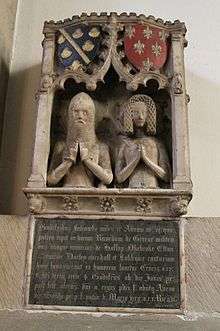Godfrey de Foljambe

Sir Godfrey de Foljambe (1317–1376) was a prominent landowner and politician in fourteenth-century England who went on to have a successful career as an Irish judge, including three years as Lord Chief Justice of Ireland. In later life he was an associate of John of Gaunt, Duke of Lancaster. His tomb can still be seen at All Saints Church, Bakewell.[1]
He was born in Derbyshire in 1317, the fourth son of Sir Thomas de Foljambe.[2] The Foljambe family were Lords of the Manor of Tideswell and also held lands at Darley Dale. Godfrey, who succeeded to the family estates after the death of his three elder brothers, also acquired the manor of Bakewell, where he founded a chantry.[2]

He sat in the House of Commons as knight of the shire for Derbyshire in several of the Parliaments of King Edward III.[2] In 1344 he went to Ireland as a Baron of the Court of Exchequer (Ireland), and was quickly transferred to the Court of King's Bench (Ireland). He served as Lord Chief Justice of Ireland from 1351 to 1354.[2]
On his return to England he sat regularly on commissions for the peace in Derbyshire and Lancashire.[2] He enjoyed the trust and confidence of John of Gaunt, for whom he acted in numerous administrative capacities, including steward for the Duchy of Lancaster. For a number of years he had a lease on a substantial part of Newcastle-under-Lyme for which he paid £127 p.a. to John of Gaunt. He died in 1376.[3]
He married (possibly his second marriage, though little is known of the first), Avena (died 1382), daughter of Sir Thomas Ireland of Hartshorne, by whom he had several sons, including Geoffrey Foljambe the younger (died 1375), and Thomas Foljambe (died 1433), who was a Baron of the Exchequer and chief steward of the duchy of Lancaster.[4] Among his descendants were Sir Francis Foljambe (died 1640), first and last of the Foljambe baronets, and the Earls of LIverpool, second creation.[5]
The mural alabaster monument to Godfrey and Avena is said to be of a very rare kind, with only two examples surviving to the present day. The Foljambe mural shows Foljambe and his wife as if they are looking out of a window and this can still be seen on the south wall of All Saints Church in Bakewell.[6] Below the mural is an explanatory inscription that dates from 1803 and was "added by Mr Blore".[7]
References
- ↑ Cox, John Charles Memorials of Old Derbyshire Bemrose and Sons 1907
- 1 2 3 4 5 Ball. F. Elrington The Judges in Ireland 1221–1921 John Murray London 1926 Vol.1 p.78
- ↑ 'Newcastle-under-Lyme: Buildings and castle', A History of the County of Stafford: Volume 8 (1963), pp. 8–15. URL: http://www.british-history.ac.uk/report.aspx?compid=53355 Date accessed: 31 August 2013
- ↑ Roskell et al (Ed). "FOLJAMBE, Thomas (d.1433), of Walton and Brimington, Derbys". History of Parliament. Inst. Of Historical Research. Retrieved 30 August 2013.
- ↑ Mosley, ed. Burke's Peerage 107th Edition Delaware 2003 Vol. 2 p. 2368
- ↑ Gardner, Arthur (2011). Alabaster Tombs of the Pre-Reformation Period in England. Cambridge University Press. p. 13. ISBN 0521166209.
- ↑ 'Parishes: Bakewell', Magna Britannia: volume 5: Derbyshire (1817), pp. 23–43. URL: http://www.british-history.ac.uk/report.aspx?compid=50721 Date accessed: 30 August 2013
| Legal offices | ||
|---|---|---|
| Preceded by John de Rednesse |
Lord Chief Justice of the King's Bench for Ireland 1351-54 |
Succeeded by John de Rednesse |